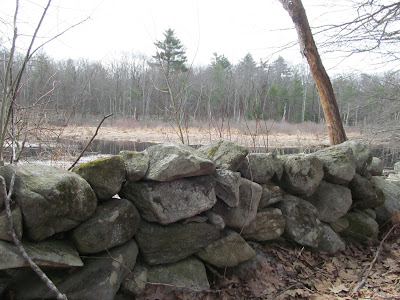The chamber is located in the Nashoba Brook Conservation Area, which has 123 acres of woodlands, wetlands, and ruins. The Nashoba Brook area really made me think about how New England has changed through the centuries.
In the 1800s Nashoba Brook was used to power light industry, like this pencil factory:
Today, the ruins of the pencil factory stand in a new growth forest:
Stone walls run through the woods and along the brook, indicating the area was once used for farmland, and the foundations of an old farmhouse can be seen near the park's entrance on Wheeler Lane. But farmers haven't worked this stony soil for many, many years.
However, the chamber itself is tall enough to stand in, and has a ceiling made of massive stone slabs. Unlike the Upton Chamber, this one had a nice dry, sandy floor, but it was still home to some large spiders.
 |
| Why am I crouching? |
 |
| It's tall enough to stand. |
The Nashoba Brook chamber had fallen into major disrepair by the end of the 20th century, but was reconstructed by local volunteers. Those are some really big rocks to move! I really admire people putting their money and manpower towards preserving our region's unique features.
 |
| Huge stone slabs form the ceiling. |
The builders and original use of the chamber have been lost in history, and there are various theories about this and the other mysterious New England stone structures out there. They could be Colonial root cellars, built by industrious farmers. The foundation of a blacksmith shop stands next to the chamber, and historic records refer to an ice house. Perhaps the man-made cave was made to keep ice from the brook cold in the winter?
Another theory is that the chamber, and others like it, were made by Native Americans. New England has been inhabited for 11,000 years, which is longer than many parts of Europe. It's entirely plausible that an earlier culture created the chambers for an unknown reason. An 8,000-year old stone tool was found near the chamber, but due to soil disruption it is impossible to definitively connect it with the structure.
The final theory is that the New England stone chambers were constructed by some Old World explorers whose visit to this continent has been forgotten. Phoenician sailors, Irish monks, and Viking warriors have all be posited as builders of these sites. I find this theory the most speculative, but it does have quite a few supporters.
In 200 years we'll all be gone and forgotten. The future New Englanders living near Nashoba Brook will curiously look at the foundations of our houses, our mysterious plastic artifacts buried in the soil, and this mysterious chamber. And then they'll develop some theories of their own.









